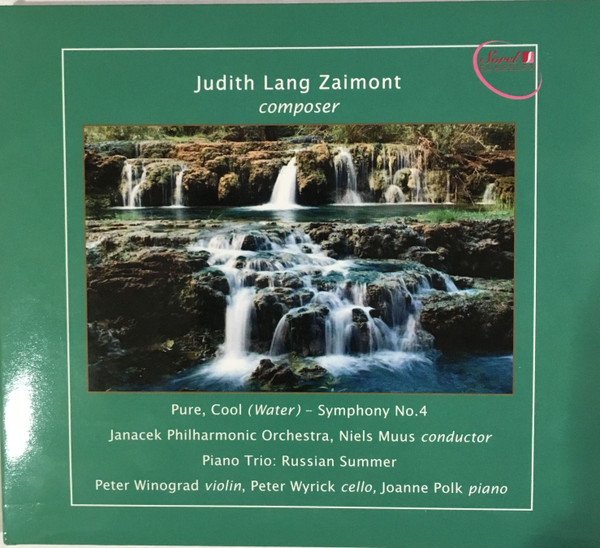Zaimont, Judith Lang / Pure Cool Water - Symphony No. 4, Piano Trio: Russian Summer
| Album: | Pure Cool Water - Symphony No. 4, Piano Trio: Russian Summer | Collection: | Classical | |
| Artist: | Zaimont, Judith Lang | Added: | Jul 2023 | |
| Label: | Abeshouse Productions | |||
A-File Activity
| Add Date: | 2023-08-13 | Pull Date: | 2023-10-15 | Charts: | Classical/Experimental |
|---|
| Week Ending: | Oct 15 | Oct 1 | Sep 10 | Aug 20 |
|---|---|---|---|---|
| Airplays: | 1 | 2 | 1 | 1 |
Recent Airplay
| 1. | Oct 23, 2023: | Mixed Up Class
V. In Waves and Torrents [Ocean], from Symphony no. 4 'Pure, cool (water)', I. In a current, from Symphony no. 4 'Pure, cool (water)' |
4. | Sep 28, 2023: | Virtually Happy
Pure, Cool Water-Symphony No. 4. A Current (The River) (13:07) |
|
| 2. | Oct 14, 2023: | Music Casserole
Falling Drops (Rainshower) (4:42) |
5. | Sep 09, 2023: | Music Casserole
In Waves and Torrents (Ocean) 12:39 |
|
| 3. | Sep 30, 2023: | Music Casserole
Falling Drops (Rainshower) (4:42) |
6. | Aug 19, 2023: | Music Casserole
Still (The Tarn) (7:34) |
Album Review
Gary Lemco
Reviewed 2023-07-06
Reviewed 2023-07-06
Judith Lang Zaimont (b. 1945) composed her Symphony No. 4 in 2013. The music celebrates water, given that her father, a chemist, specialized in water treatment and control. Her love of Nature begins here.
“Pure, Cool Water” - Symphony No. 4. A current (The River) proceeds out of a long pedal point, the syntax tonal in an American style reminiscent of Copland or Gould. At 8:00, the tempo picks up from the dream pattern and becomes animated, using percussion, brass, and individual winds. The idea of water’s flow is paramount here, set in 4/4 and moving to a tuned, crystal bell in G Major. As a solid (ice) portrays a bleak landscape, using upper strings, winds, vibraphone, and trumpet. The writing feels jagged and austere, with outbursts from low brass and contrabasses. falling drops (Rainshower) serves a scherzo in aerial, bi-tonal terms, scored for percussion, bassoons, low brass, and non-pitched Instruments, like cymbals and clappers. The music strikes up a march, reminiscent of Shostakovich or Copland. The coda simply evaporates. still (The Tarn) depicts a deep water lake, static but structured as a theme and variations. Woodwinds: clarinet, flute, and oboe dominate the texture over soft strings. A solo cello has a moment. The timpani and cymbals suggest the depth of the water, maybe Crater Lake. waves and torrents (Ocean) may remind some listeners of Debussy’s La Mer. The music suggests quiet, then crests and active force in the tides. While brass and percussion emerge, so does a prominent solo violin and flute part. After an extended period of calm, the music builds itself back up incrementally to embrace the full orchestra.
Piano Trio No. 1 “Russian Summer” (1989). Nocturne indulges sarabande (Spanish) rhythm, with cello and violin pairing over the piano’s harp like sounds. The composer claims the piece has Russian, Polish, and Hungarian roots. The parlando (sung-spoken) style may remind some of Ravel, but the syntax can become harsher and more percussive, despite the meditative tone.
Romp invokes the spirit of Haydn, a gypsy rondo in that ends in A Major. The three instruments play an outgoing, exuberant gypsy-style that has “symphonic” ambitions with colorful effects.
“Pure, Cool Water” - Symphony No. 4. A current (The River) proceeds out of a long pedal point, the syntax tonal in an American style reminiscent of Copland or Gould. At 8:00, the tempo picks up from the dream pattern and becomes animated, using percussion, brass, and individual winds. The idea of water’s flow is paramount here, set in 4/4 and moving to a tuned, crystal bell in G Major. As a solid (ice) portrays a bleak landscape, using upper strings, winds, vibraphone, and trumpet. The writing feels jagged and austere, with outbursts from low brass and contrabasses. falling drops (Rainshower) serves a scherzo in aerial, bi-tonal terms, scored for percussion, bassoons, low brass, and non-pitched Instruments, like cymbals and clappers. The music strikes up a march, reminiscent of Shostakovich or Copland. The coda simply evaporates. still (The Tarn) depicts a deep water lake, static but structured as a theme and variations. Woodwinds: clarinet, flute, and oboe dominate the texture over soft strings. A solo cello has a moment. The timpani and cymbals suggest the depth of the water, maybe Crater Lake. waves and torrents (Ocean) may remind some listeners of Debussy’s La Mer. The music suggests quiet, then crests and active force in the tides. While brass and percussion emerge, so does a prominent solo violin and flute part. After an extended period of calm, the music builds itself back up incrementally to embrace the full orchestra.
Piano Trio No. 1 “Russian Summer” (1989). Nocturne indulges sarabande (Spanish) rhythm, with cello and violin pairing over the piano’s harp like sounds. The composer claims the piece has Russian, Polish, and Hungarian roots. The parlando (sung-spoken) style may remind some of Ravel, but the syntax can become harsher and more percussive, despite the meditative tone.
Romp invokes the spirit of Haydn, a gypsy rondo in that ends in A Major. The three instruments play an outgoing, exuberant gypsy-style that has “symphonic” ambitions with colorful effects.
Track Listing
